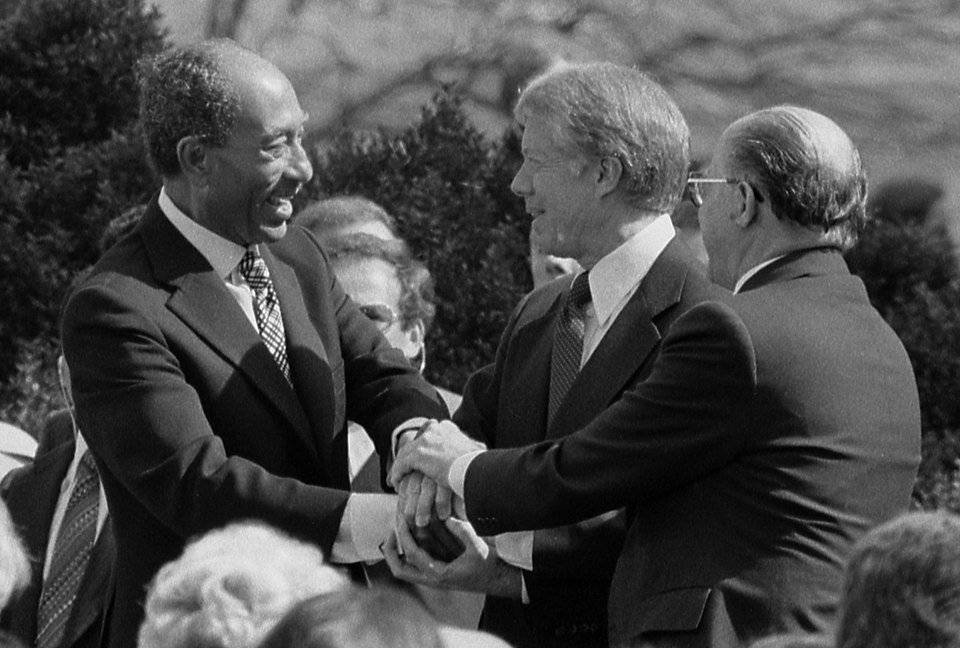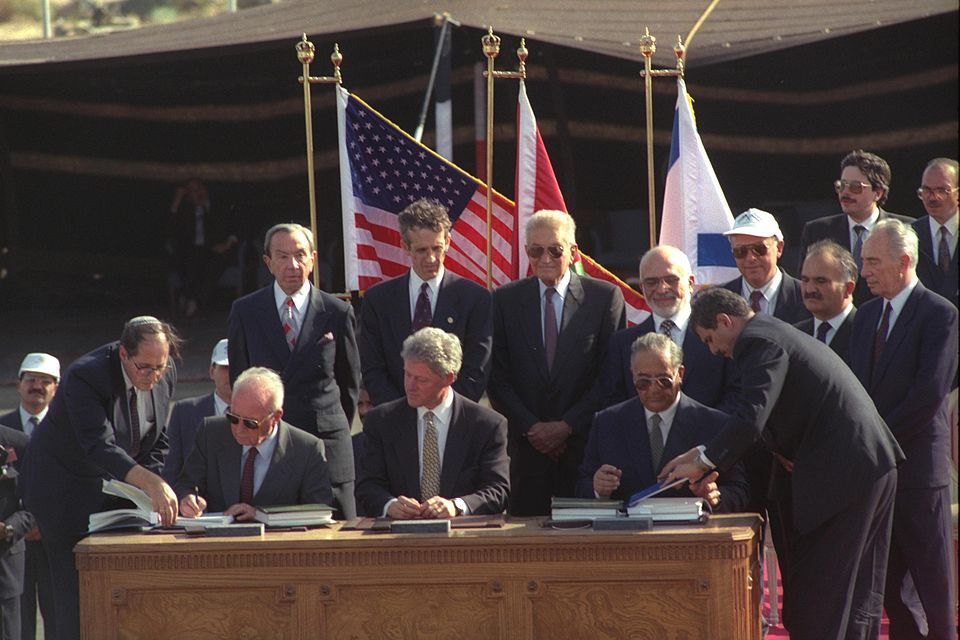IB Syllabus focus:
'Analyze the relationships between Arab states and the relationship of Arab states (individually and/or collectively) with Israel following the 1973 War.
Investigate attempts at peacemaking, including the Camp David Accords (2000).'
The aftermath of the 1973 War, also known as the Yom Kippur War, marked a turning point in the relationships between Arab states and Israel. The subsequent decades have been characterised by a series of negotiations, shifting alliances, and fluctuating periods of conflict and peace.
Evolution of Arab-Israeli Relations
Post-1973 War Shifts
The 1973 War ended with both a military and political impact, leading to a new strategic balance in the region.
Oil embargoes implemented by Arab states during the war led to the global energy crisis and brought international focus to the region.
Changing Political Landscapes
The war induced a sense of pragmatism among some Arab leaders, especially Egypt, concerning the impossibility of eradicating the state of Israel.
Recognition of the need for diplomatic solutions to achieve political and territorial goals began to take root.
The Road to Camp David
Egyptian-Israeli Detente
President Anwar Sadat of Egypt took a monumental step by visiting Jerusalem in 1977, indicating his willingness to negotiate directly with Israel, breaking Arab solidarity.
Sadat's motivations included the desire to recover the Sinai Peninsula and secure economic and military aid from the United States.
The Camp David Accords (1978)
The accords were a series of agreements facilitated by US President Jimmy Carter, culminating in the Egypt-Israel Peace Treaty of 1979.
Egypt became the first Arab country to officially recognise Israel, which agreed to gradually withdraw from the Sinai Peninsula.

On March 26, 1979, Egyptian President Anwar Sadat, U.S. President Jimmy Carter, and Israeli Prime Minister Menachem Begin clasp hands on the White House grounds after signing the Egypt–Israel Peace Treaty. The agreement ended the state of war between the two countries and set terms for Israel’s withdrawal from the Sinai Peninsula. It marked the first formal peace between Israel and an Arab state. Source
Arab League and the Pan-Arab Response
Division and Discord
Egypt's separate peace with Israel was met with outrage by other Arab states, leading to Egypt's temporary expulsion from the Arab League.
The response highlighted the division within the Arab world regarding peace with Israel and the broader approach to the Palestinian issue.
The Fez Initiative
Proposed by Saudi Arabia, this plan outlined a framework for comprehensive peace based on Israel's withdrawal and the establishment of a Palestinian state with East Jerusalem as its capital.
The plan indicated an implicit recognition of Israel but also exposed the division within the Arab League on how to deal with the Israel-Palestinian conflict.
The Peace Process: From Oslo to Camp David 2000
The Oslo Accords
Initiated a process aimed at fulfilling the "right of the Palestinian people to self-determination."
Created the Palestinian Authority but left key issues like Jerusalem, refugees, and final borders unresolved.
Camp David Summit 2000
The summit, hosted by US President Bill Clinton, included Israeli Prime Minister Ehud Barak and PLO Chairman Yasser Arafat.
Despite intense negotiations, the summit failed to produce a final agreement, primarily due to disagreements over Jerusalem and Palestinian refugees.
Bilateral Relations: Jordan and Beyond
Jordan's Peace Treaty with Israel
Following Egypt, Jordan signed a peace treaty with Israel in 1994, normalising relations and resolving territorial disputes.

On October 26, 1994, Israel and Jordan signed a peace treaty at the Wadi Araba/Arava border crossing. Prime Minister Yitzhak Rabin, U.S. President Bill Clinton, and Jordanian Prime Minister Abdelsalam al-Majali presided over the ceremony, symbolizing a further step in Arab–Israeli normalization after 1973. The agreement settled borders and opened the door to cooperation despite domestic opposition in both countries. Source
The treaty exemplified the possibility of Arab-Israeli cooperation but was also met with internal and regional opposition.
Lebanon and Syria
Lebanon, influenced heavily by Syria and non-state actors like Hezbollah, remained technically at war with Israel.
Syria's negotiations with Israel have repeatedly stalled, primarily over the Golan Heights, captured by Israel in the 1967 Six-Day War.
The Influence of Non-Arab Regional Powers
Iran's Opposition
After the 1979 Islamic Revolution, Iran adopted a policy of strong opposition to Israel, supporting groups such as Hezbollah.
Iran's stance has often contrasted with that of more moderate or Western-aligned Arab states.
Turkey's Balancing Act
Turkey maintained diplomatic relations with Israel while also seeking to preserve its ties with Arab states and its image in the Muslim world.
Challenges and Attempts at Resolution
Intifadas and the Peace Process
The First (1987-1993) and Second (2000-2005) Intifadas in the occupied Palestinian territories presented significant challenges to the peace process.
The uprisings highlighted the Palestinian demand for independence and the high cost of the ongoing occupation.
The Madrid Conference
In 1991, this conference laid the groundwork for future negotiations by bringing together Israel, the Palestinians, and neighbouring Arab states.
The conference was a precursor to the Oslo Accords and set a precedent for multilateral peace talks.
The Arab Peace Initiative and the Future
A New Proposal
Launched by Saudi Arabia in 2002 and endorsed by the Arab League, it offered full normalisation of relations in return for a complete withdrawal by Israel from occupied territories and a "just settlement" of the Palestinian refugee issue.
The initiative has been referenced in numerous diplomatic efforts but has yet to be fully implemented.
Shifting Regional Dynamics
The geopolitical landscape in the Middle East continues to evolve with alliances shifting, such as the recent Abraham Accords between Israel, the United Arab Emirates, Bahrain, Sudan, and Morocco.
These accords reflect a potential paradigm shift in the approach of some Arab states towards Israel, prioritising geopolitical and economic benefits over longstanding political stances.
The dynamic of Arab-Israeli relations has been one of the most complex and evolving aspects of Middle Eastern politics since the 1973 War. Each decade has brought changes and challenges, from the landmark Camp David Accords to the fluctuating peace process of the 1990s and beyond. The narrative continues to develop, with historical grievances and aspirations still at the heart of the discourse.
FAQ
After the 1973 War, the United Nations played a significant role in facilitating peace efforts between Arab states and Israel. The UN Security Council adopted Resolution 338, calling for an immediate ceasefire and negotiations under appropriate auspices aimed at establishing a just and durable peace. The resolution also led to the Geneva Conference in December 1973, an attempt to involve the broader international community in resolving the conflict. Throughout the ensuing decades, the UN provided forums for dialogue, passed resolutions condemning actions by both sides that were seen as obstacles to peace, and established peacekeeping missions to reduce tensions, such as the United Nations Interim Force in Lebanon (UNIFIL). While the UN's effectiveness was often limited by geopolitical realities and the veto power of Security Council members, it remained a key international actor in the ongoing quest for peace in the region.
The Oslo Accords had a mixed impact on the relationships between Arab states and Israel. On one hand, they marked a significant step forward by introducing a framework for peace and recognising the Palestinian National Authority. This encouraged some Arab countries to soften their stance towards Israel, with countries like Jordan signing a peace treaty in 1994. However, the Accords also exposed deep divisions among Arab states, with hardliner countries such as Syria and Libya condemning the process. Additionally, the failure to resolve key issues like Jerusalem and settlements maintained a level of scepticism among many Arab states about Israel's commitment to a comprehensive peace. Overall, while the Oslo Accords moved some Arab states towards a more conciliatory position, they also highlighted the limits of what such negotiations could achieve without broader regional buy-in.
The rise of Islamist political movements has had a significant impact on Arab-Israeli peace efforts. These movements, often rooted in opposition to secular Arab governments and their Western-aligned policies, frequently adopted a stance of uncompromising resistance to Israel. The Islamic Revolution in Iran in 1979 led to the emergence of a new regional player vehemently opposed to Israel's existence. Similarly, the rise of Hamas in Palestinian politics, particularly its electoral victory in 2006, brought a group to prominence that rejected the Oslo peace process and called for the liberation of all historic Palestine. The influence of Islamist movements introduced an additional layer of complexity to the peace efforts, as they often prioritised ideological objectives over political pragmatism, making the negotiation of a comprehensive peace agreement more challenging.
The main obstacles to achieving lasting peace following the Camp David Accords stemmed from issues that were not fully resolved by the agreements. These included the status of Jerusalem, which both Israelis and Palestinians claim as their capital, the right of return for Palestinian refugees, the borders of a future Palestinian state, and the continuing Israeli settlements in the occupied territories. The Camp David Accords focused primarily on Egypt and Israel, leaving the broader Palestinian question largely unaddressed. The divergent political, social, and religious views between Israel and various Arab entities further complicated the situation. Additionally, the resistance from other Arab states and factions within Palestine, including the emergence of groups like Hamas, reflected the widespread dissatisfaction with the accords and the process they initiated.
Internal politics within Arab states had a profound influence on their foreign policies towards Israel after the 1973 War. For instance, Egypt, under President Sadat, shifted its policy from Nasser’s staunch opposition and confrontation to a more pragmatic approach which led to the peace treaty with Israel. Sadat faced substantial internal resistance and was ultimately assassinated for his decision. Syria and Iraq, with their Ba'athist regimes, maintained a hardline stance which influenced their continued hostility towards Israel. Jordan’s monarchy, which had a significant Palestinian population, navigated a more moderate path, balancing internal pressures with the strategic necessity of peace, eventually leading to the 1994 treaty with Israel. Saudi Arabia, whilst not directly involved in the conflicts, used its influence and wealth to sponsor peace initiatives such as the Fez Plan and the Arab Peace Initiative, aligning with its position as a religious and economic leader in the Arab world.
Practice Questions
The Camp David Accords were a watershed moment in Arab-Israeli relations, marking the first peace agreement between Israel and an Arab country. The accords' significance lies in their symbolic break from the previously unyielding Arab solidarity against Israel, setting a precedent for Arab recognition of Israel's right to exist. This move by Egypt under President Sadat, although controversial in the Arab world, opened the door for future peace negotiations and realigned the regional power structure. It demonstrated the possibility of diplomatic resolution to seemingly intractable conflicts, and its legacy is seen in subsequent peace efforts, even if the broader peace envisioned at Camp David has yet to materialise fully.
The 1973 War fundamentally altered the political landscape of the Middle East. It shattered the perception of Israeli invincibility following the 1967 Six-Day War, thus restoring Arab pride and leading to a more balanced approach in future negotiations. The war prompted a shift from reliance on military solutions to a greater openness towards diplomacy, exemplified by the ensuing peace processes such as the Camp David Accords. Moreover, the use of oil as an economic weapon by Arab states during the conflict highlighted the Middle East's strategic importance on a global scale, linking regional politics with international economics and drawing extensive superpower involvement in the region's affairs.

